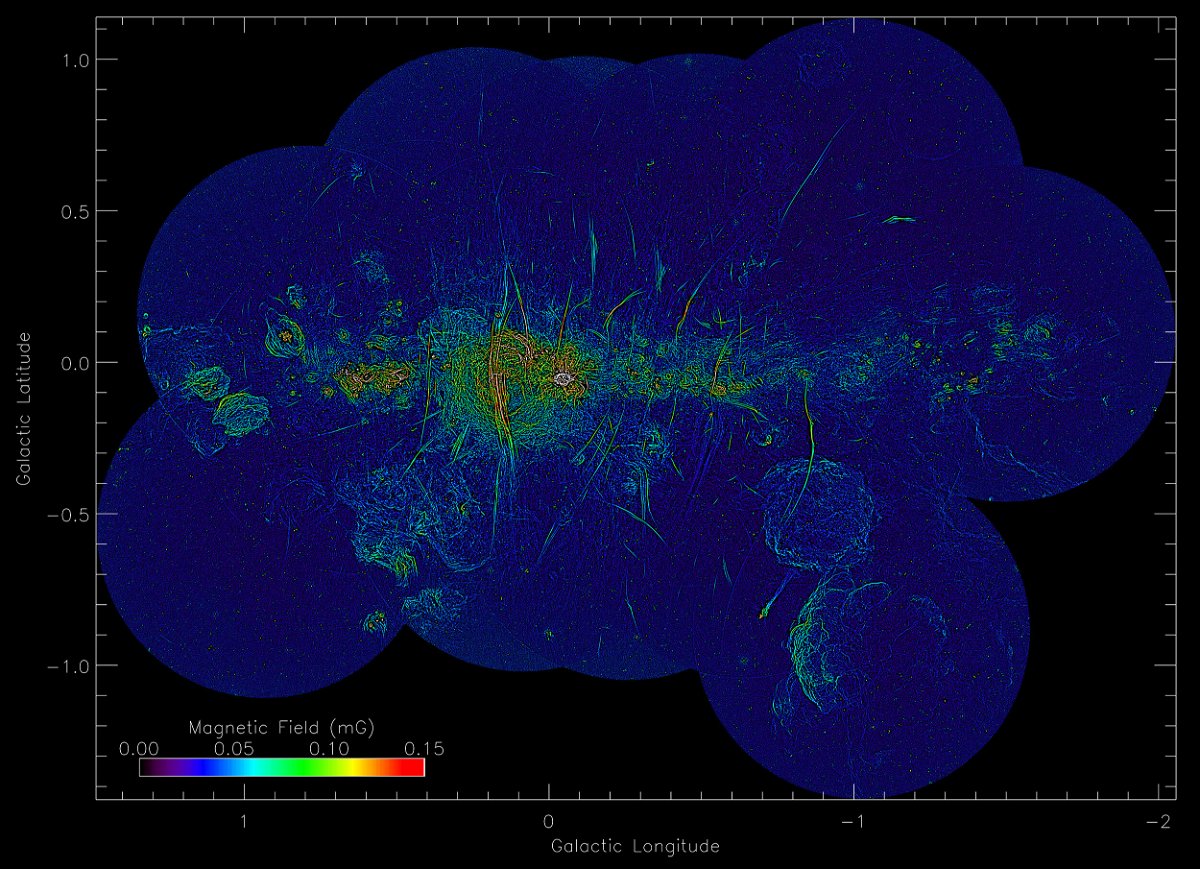Hundreds of mysterious strands found at the heart of the Milky Way

This colorized image depicts the strengths of magnetic fields generated by the strands.
By Ashley Strickland, CNN
The center of our Milky Way galaxy is home to a multitude of intriguing features — including nearly a thousand mysterious magnetic strands, according to a new telescope image.
The pairs and clusters of strands stretch for nearly 150 light-years in length and are equally spaced. The bizarre structures are a few million years old and vary in appearance. Some of them resemble harp strings, waterfalls or even the rings around Saturn.
But the true nature of the filaments remains elusive.
Farhad Yusef-Zadeh, a professor of physics and astronomy at Northwestern University, first discovered the strands 35 years ago via radio waves. He determined that the strands were made of cosmic ray electrons that were moving their magnetic fields at near the speed of light. The origin of these strands, however, has remained a mystery.
Now, astronomers were able to find 10 times more strands than Yusef-Zadeh’s previous discovery, using the South African Radio Astronomy Observatory MeerKAT telescope.
A study detailing these findings as been accepted for publication in The Astrophysical Journal Letters.
“We have studied individual filaments for a long time with a myopic view,” said Yusef-Zadeh, lead study author and member of Northwestern’s Center for Interdisciplinary Exploration and Research in Astrophysics, in a statement.
“Now, we finally see the big picture — a panoramic view filled with an abundance of filaments. Just examining a few filaments makes it difficult to draw any real conclusion about what they are and where they came from. This is a watershed in furthering our understanding of these structures.”
The new, detailed image is actually composed from a mosaic of 20 different observations taken over three years while looking toward the Milky Way’s distant center, located 25,000 light-years from Earth.
In addition to the long strands, the image shows the signatures of star birth and the remnants of exploded stars through radio emissions. Yusef-Zadeh and his research team focused solely on the strands and isolated them from the other phenomena captured in the image.
“It’s like modern art,” he said. “These images are so beautiful and rich, and the mystery of it all makes it even more interesting.”
Separating the strands
The amount of radiation varied from other energetic cosmic events, like supernova remnants, the team’s analysis of the strands showed. The scientists think the strands are more likely related to past activity caused by the supermassive black hole at the center of the Milky Way rather than the explosions of stars.
The team also determined that magnetic fields are stronger along the strands.
Studying a larger group of the strands is allowing scientists to better understand them, although many mysteries remain.
“If you were from another planet, for example, and you encountered one very tall person on Earth, you might assume all people are tall,” Yusef-Zadeh said. “But if you do statistics across a population of people, you can find the average height. That’s exactly what we’re doing. We can find the strength of magnetic fields, their lengths, their orientations and the spectrum of radiation.”
As the team works to identify each strand, they are still trying to figure out the orderly, equal distance between clusters of strands, the cause of the particle acceleration. or if the strands move over time.
“Every time we answer one question, multiple other questions arise,” Yusef-Zadeh said. “How do you accelerate electrons at close to the speed of light? One idea is there are some sources at the end of these filaments that are accelerating these particles.”
It’s possible that strands are connected with a previous discovery by Yusef-Zadeh and his team in 2019: giant balloon structures at the heart of the galaxy.
Multiple studies about the strands will be published in the future, and scientists hope to uncover how they fit in among the tangle of objects near the center of the Milky Way.
“We’re hoping to get to the bottom of it, but more observations and theoretical analyses are needed,” he said. “A full understanding of complex objects takes time.”
The-CNN-Wire
™ & © 2022 Cable News Network, Inc., a WarnerMedia Company. All rights reserved.

